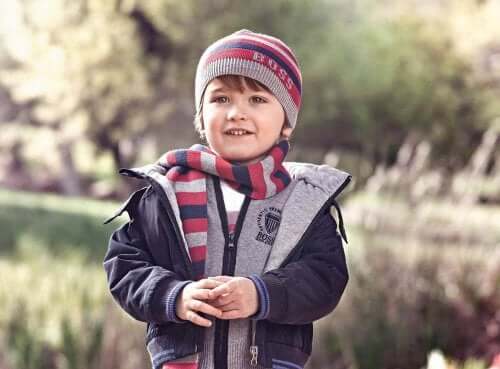When Should Your Kids Start Dressing Themselves?

One important step on your children’s road to maturity is when they start dressing themselves for the first time. This allows them to demonstrate their independence and autonomy.
Most children begin to dress and undress on their own between the ages of three and five. By five or six, they’ll be able to do even more things on their own.
We must keep in mind that all children learn at their own pace, but this isn’t something they need to face alone. It’s recommended that parents encourage them, especially when they notice that their children are showing signs of wanting to do it by themselves.
In the early days, they’ll need help, but will gradually require less and less. Practice helps them master the skill, but you should avoid rushing them so they don’t become frustrated if it doesn’t come out right. Congratulations are in order every time they do it right. This is a good way to motivate them to keep learning.
No matter how long it takes them to learn, once they finally get it right, they’ll gain a sense of independence as well as self-confidence. This will help them cope better in school and while doing other activities.
For some children, dressing themselves is something they learn by age two, while others take until about four. There is nothing to worry about in either case; each child learns at their own pace.
We must remember that all children find getting undressed easier than getting dressed. They also find it easier to put on pants than it is to put on shirts.
How to teach children to start dressing themselves
It’s best to start this process as early as possible. You can begin when children shows a willingness to learn how. They’ll usually start trying around two years old, as this is the age when they want to be more independent.
Parents need to be patient. It’s very important that you don’t pressure your child to go faster. Start small and do it when you have the time.
Also, remember to praise your children every time they show progress. This can provide motivation for the child to continue to improve.

From easy to difficult
Try starting with socks and underwear, leaving tops for last. When the child learns to put on a garment correctly, move on to the next one. Another suggestion is to teach them how to dress using simple clothes with easy snaps to make things less complicated.
Your best bet for success is to begin with clothes that children can manage. It’s important to choose wide shoes that are easy to put on and take off. Also avoid laces; start with velcro instead. In terms of the upper body, try shirts with flexible necks that are big enough for children to put their heads through without difficulty.
Meanwhile, choose loose pants with elastic waistbands before gradually moving on to pants with snaps. With respect to dresses, try to pick ones that are easy to put on and take off and don’t feature buttons or zippers on the back. Wide elastic dresses are best since children will find them easier to take off.
“All children find getting undressed easier than getting dressed. They also find it easier to put on pants than it is to put on shirts.”
Advice for teaching your children to dress themselves
It’s essential to establish a consistent daily schedule. This way, children will know what they have to do at any given time.
Once you’ve begun to teach them to dress on their own, they need to stick with it. If one day they put on their own socks and the next their parents do it for them, they won’t learn that they need to do it themselves.
You need to be patient, given that the child will go slowly at first. The best thing is to figure out how much time it should take so you don’t find yourself in a hurry.
The easiest way to approach this is for the parents to choose the clothes that their children will wear. However, it’s recommended to let children pick out a garment in order to motivate them and let them feel more independent.
Finally, using songs and games is a good way to help them learn to dress while having fun. They can also learn by watching you do it. Given that they’re in an imitation stage, it will be easier for them to copy you while the process is explained.

Dealing with frustration as the child learns
It’s natural for children to feel a little frustrated, but it’s something they need to learn to overcome. Providing small doses of autonomy is the only way they’ll learn to deal with frustration.
If your children don’t ask for help, don’t interrupt or intervene. If they tell you they can’t do it, try to encourage them to finish the task without help.
Finally, remember that it’s never too late for children to learn to start dressing themselves. Their minds absorb a lot and they’re always open to learning. As a parent, you need to do one fundamental thing: trust your child.
One important step on your children’s road to maturity is when they start dressing themselves for the first time. This allows them to demonstrate their independence and autonomy.
Most children begin to dress and undress on their own between the ages of three and five. By five or six, they’ll be able to do even more things on their own.
We must keep in mind that all children learn at their own pace, but this isn’t something they need to face alone. It’s recommended that parents encourage them, especially when they notice that their children are showing signs of wanting to do it by themselves.
In the early days, they’ll need help, but will gradually require less and less. Practice helps them master the skill, but you should avoid rushing them so they don’t become frustrated if it doesn’t come out right. Congratulations are in order every time they do it right. This is a good way to motivate them to keep learning.
No matter how long it takes them to learn, once they finally get it right, they’ll gain a sense of independence as well as self-confidence. This will help them cope better in school and while doing other activities.
For some children, dressing themselves is something they learn by age two, while others take until about four. There is nothing to worry about in either case; each child learns at their own pace.
We must remember that all children find getting undressed easier than getting dressed. They also find it easier to put on pants than it is to put on shirts.
How to teach children to start dressing themselves
It’s best to start this process as early as possible. You can begin when children shows a willingness to learn how. They’ll usually start trying around two years old, as this is the age when they want to be more independent.
Parents need to be patient. It’s very important that you don’t pressure your child to go faster. Start small and do it when you have the time.
Also, remember to praise your children every time they show progress. This can provide motivation for the child to continue to improve.

From easy to difficult
Try starting with socks and underwear, leaving tops for last. When the child learns to put on a garment correctly, move on to the next one. Another suggestion is to teach them how to dress using simple clothes with easy snaps to make things less complicated.
Your best bet for success is to begin with clothes that children can manage. It’s important to choose wide shoes that are easy to put on and take off. Also avoid laces; start with velcro instead. In terms of the upper body, try shirts with flexible necks that are big enough for children to put their heads through without difficulty.
Meanwhile, choose loose pants with elastic waistbands before gradually moving on to pants with snaps. With respect to dresses, try to pick ones that are easy to put on and take off and don’t feature buttons or zippers on the back. Wide elastic dresses are best since children will find them easier to take off.
“All children find getting undressed easier than getting dressed. They also find it easier to put on pants than it is to put on shirts.”
Advice for teaching your children to dress themselves
It’s essential to establish a consistent daily schedule. This way, children will know what they have to do at any given time.
Once you’ve begun to teach them to dress on their own, they need to stick with it. If one day they put on their own socks and the next their parents do it for them, they won’t learn that they need to do it themselves.
You need to be patient, given that the child will go slowly at first. The best thing is to figure out how much time it should take so you don’t find yourself in a hurry.
The easiest way to approach this is for the parents to choose the clothes that their children will wear. However, it’s recommended to let children pick out a garment in order to motivate them and let them feel more independent.
Finally, using songs and games is a good way to help them learn to dress while having fun. They can also learn by watching you do it. Given that they’re in an imitation stage, it will be easier for them to copy you while the process is explained.

Dealing with frustration as the child learns
It’s natural for children to feel a little frustrated, but it’s something they need to learn to overcome. Providing small doses of autonomy is the only way they’ll learn to deal with frustration.
If your children don’t ask for help, don’t interrupt or intervene. If they tell you they can’t do it, try to encourage them to finish the task without help.
Finally, remember that it’s never too late for children to learn to start dressing themselves. Their minds absorb a lot and they’re always open to learning. As a parent, you need to do one fundamental thing: trust your child.
All cited sources were thoroughly reviewed by our team to ensure their quality, reliability, currency, and validity. The bibliography of this article was considered reliable and of academic or scientific accuracy.
- Vallet, M. (2007). Educar a niños y niñas de 0 a 6 años. WK Educación.
- Silvestre Ramos, B. L. (2019). La sobreprotección en la autonomía de los niños de 3 a 5 años. http://repositorio.untumbes.edu.pe/handle/UNITUMBES/1367
- Silva Forero, M. C. (2008). Desarrollo de la identidad y personalidad de niños (3-5 años) (Bachelor’s thesis, Bogotá-Uniandes). https://repositorio.uniandes.edu.co/bitstream/handle/1992/20510/u336437.pdf?sequence=1
- Ccallo Huillca, C. (2019). El desarrollo de la autonomía en los niños y niñas de 3 años del IEI N° 858 Huanatinco-Cusco. http://repositorio.unap.edu.pe/handle/UNAP/12478
This text is provided for informational purposes only and does not replace consultation with a professional. If in doubt, consult your specialist.








